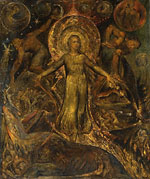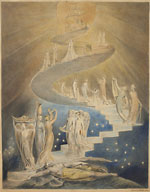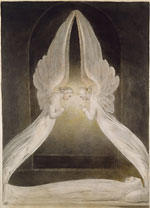If at First…
London’s Tate Gallery Reprises William Blake’s One-Man Flop. By Steve HareThe writer is a freelance journalist who works part-time for the Tate Collection.
The poet and artist William Blake (1757-1827) has been dead for nearly 200 years, yet his stock has never been higher. The Petit Palais in Paris is showing works by Blake starting this month (April 1-June 28). The Louvre recently paid a record price at Sotheby’s to own a Blake watercolour. The British Broadcasting Company ranks Blake number 37 in its poll of the top 100 “Great Britons”; Blake was the only visual artist to make the cut. The Tate Gallery in London, which owns 176 works by Blake—enough to fill several museums—now regularly exhibits works by the favorite son. And for its next exhibition (Apr. 20-Oct. 4), the Tate is showing just 11 works by Blake, in a remarkable, near perfect, recreation of the artist’s single, doomed attempt at a one-man show, exactly 200 years ago.
It’s only near perfect, because while Blake presented 16 works, not all of them still exist. Of the original 16, Tate has several in its own collection, and has managed to locate and borrow all but one of the known survivors from the V&A, British Museum, the Fitzwilliam in Cambridge and Southampton Art Gallery. One further work remains in an American institution. That work, Cain Fleeing from the Wrath of God, is represented by an almost identical work from the Tate Collection.
It’s only near perfect, too, because the Victorian splendour of the Tate Gallery can only ever be a poor facsimile of Blake’s own “gallery”: he held his show in his small lodgings, above his brother’s hosiery shop in central London, just north of Golden Square.
These days the square houses a number of film businesses and the headquarters of the global ad agency M&C Saatchi. Had he been around in 1809, Charles Saatchi would surely have attended such a show; he might even have bought the entire collection. These days Saatchi rarely concerns himself with ad-land, preferring to collect and display works that met with a certain derision and scorn on their first showing.
William Blake knew all about derision and scorn. In 1809 he was pushing 42, a little-known, middle-aged poet, artist and printmaker trying to change his fortunes and public appreciation by putting on this show. He had, remarkably, created and perfected his own printmaking process, “relief etching,” which allowed him to combine color, texts and images: an extraordinary technique still not fully understood today.
Oh, and he had visions. He already had something of a reputation for politically dangerous eccentricity, which was believed to border on madness. The exhibition did nothing to dispel such beliefs.
He printed up flyers announcing an ‘Exhibition of Paintings in Fresco, Poetical and Historical Inventions, by Wm. Blake’ at ‘No.28, Corner of Broad Street*, Golden-Square.’ There was an entrance fee of 2/6d, a substantial sum then, though it included the “Descriptive Catalogue.” This promised “the grand Style of Art restored; in FRESCO, or Water-colour Painting, and England protected from the too just imputation of being the Seat and Protectoress of bad (that is blotting and blurring) Art.”
Blake immodestly claimed his exhibition presented “real Art, as it was left us by Raphael and Albert Durer, Michael Angelo, and Julio Romano.”
Of the 16 paintings—ostensibly all for sale—it is now apparent that some were commissioned works, borrowed back for the exhibition. There is no single unifying theme or style; while some are classic Blake, others have a Pre-Raphaelite or even art nouveau feel. Religious themes abound, alongside a recreation of Chaucer and allegorical representations of Nelson and William Pitt.
Most, as you would expect given Blake’s cramped quarters, were of modest size, though one—Ancient Britons—was a massive 3x4 metres. Unfortunately this is one of the missing works, and its sheer visual impact can never be experienced. Tate curator Martin Myrone, who has written a book to accompany the exhibition, which includes the complete catalogue text, believes that Blake’s doomed show was “not merely a celebration of an artist’s work, a straightforward retrospective view of a carer, but an agenda-setting, forcefully polemical, intervention into the art world, and an enterprise aimed at reforming not only the tastes of the public, but their morality as well, through the revival of the ‘Grand style’ in art.”
The 1809 exhibition opened and then dragged on for months and months, as nothing in it sold, and few visitors were attracted other than Blake’s increasingly confused friends. One such, George Cumberland wrote that Blake’s catalogue, whilst truly original, was “part vanity, part madness—part very good sense.” It attracted a solitary review in The Examiner of 17 March 1809, in which the critic Robert Hunt opined that “the poor man fancies himself a great master, and has painted a few wretched pictures, some of which are unintelligible allegory, others an attempt at sober character by caricature representation, and the whole blotted and blurred and very badly drawn. These he calls an Exhibition, of which he has published a Catalogue, or rather a farrago of nonsense, unintelligibleness, and egregious vanity, the wild effusions of a distempered brain.”
It would not have been surprising if Blake had just given up. He was destined, like countless other artists of similar stature, to find fame and recognition only posthumously. Along with his unique, visionary art he also left us an endless store of quotable quotes, any one of which would provide a suitable sign-off. ‘What is now proved was once only imagined,’ seems to fit the bill perfectly.











